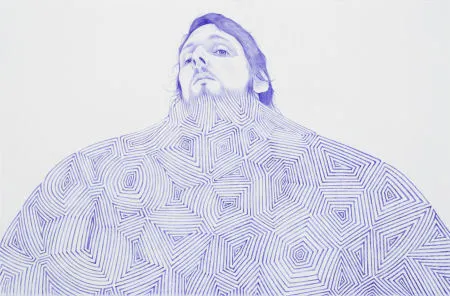Laith McGregor
- lsimonsart
- Aug 24
- 3 min read

Laith McGregor's practice consistently returns to drawing as its foundation, although his career spans sculpture, installation, video, and printmaking. Drawing, being central to how McGregor thinks and works, is not just a preparatory step or secondary medium. He uses it as a space to test ideas about identity, memory, and representation, often using the simplest of tools such as biro, pencil, and ink.
McGregor's biro portraits (below) helped build his early recognition. These works present a commitment to his process—hours of repetative marks piecing together highly detailed faces, often of himself or figures from his life. At first glance they resemble the language of traditional portraiture: careful likeness, close observation, and an emphasis of features. McGregor chooses to disrupt and complicate these conventions. He exaggerates beards, hair, and other facial details, or repeats them to the point where they function more as masks and less as identifiers. He looks at how portraiture can capture identity when identity itself can be constructed and performed. The beards in particular link to ideas of adulthood, masculinity, and diguise. These portraits appear personal, also becoming generic and stereotypical, moving the focus from likeness to more broud question of how self if presented.
Image 1: “Laith McGregor.” 2010. For Us - by Us. August 22, 2010. https://theroadleadstor.wordpress.com/2010/08/22/laith-mcgregor/.
Image 2: “Laith McGregor.” 2010. For Us - by Us. August 22, 2010. https://theroadleadstor.wordpress.com/2010/08/22/laith-mcgregor/.
Image 3: “Laith McGregor.” 2010. For Us - by Us. August 22, 2010. https://theroadleadstor.wordpress.com/2010/08/22/laith-mcgregor/.
Taking a closer look at the third image above, we can see a pattern emerge naturally. The lines when repeated multiple times, start opperating both descriptively and decoratively. In the face, shadows are shown through hatching, yet the density move the surfaces to feel more abstract. The face is revealed and obscured by the biro lined pattern as it transitions into the beard. In this work, both pattern and portrait exist together cohesively.
McGregor's work demonstrates that drawing can blur between portrait and pattern, representation an abstraction, personal expression and collective sign. His practice showcases how repeating and layered, basic mark-making can create works that question not only how we see, but also how we recognise what we see, and how we understand self.
Looking at other drawings

This work complicates portraiture through surface treatment. The head of a long-haired man is drawn in pencil, and then a layer of patterned linear marks has been drawn over the top in biro. These lines exten across the background and the face, disrupting and obscuring its features. The pattern interrupts identity while also structuring it.

In this drawing, McGregor pulls the images back to a fragment. There is only a partial face drawn with biro, while the rest of the face is fading into a second faint head drawn with a wash of pale blue ink. By using both the biro drawing, and pale wash of ink, the drawing situates between presence and absence.

This drawing utilises a system of repeated of repeated linear lines. These lines form the figure of a robed man in a patterned field. The repeated short marks create rhythm and density within the image. The pattern here doesn't just fill the page as it is the system through which the portrait can exist.
ASGA. “Laith McGregor.” AGSA - The Art Gallery of South Australia, n.d. https://www.agsa.sa.gov.au/education/resources-educators/resources-educators-australian-art/2022-adelaide-biennial-of-australian-art-freestate/laith-mcgregor/.
irismagazine. “Laith McGregor.” Iris Magazine, April 7, 2015. https://www.irismagazine.com/issue-one/laith-mcgregor.
Station Gallery. “Laith McGregor - Station Gallery.” Stationgallery.com, 2022. https://stationgallery.com/artist/laith-mcgregor/?srsltid=AfmBOooGMAgSS-a14EyIIVknzWR-pu-ZW6ivIBZU3cSTjQPK3GqTZQ-h.






